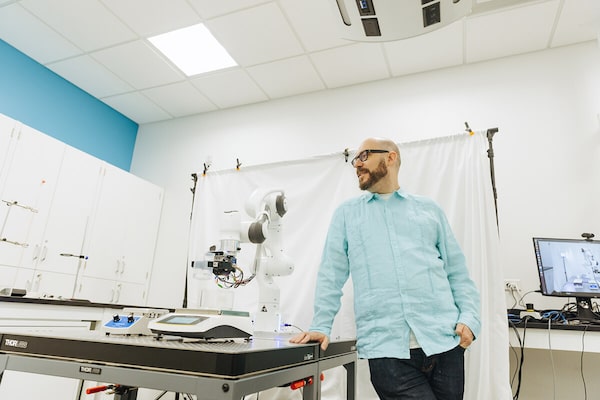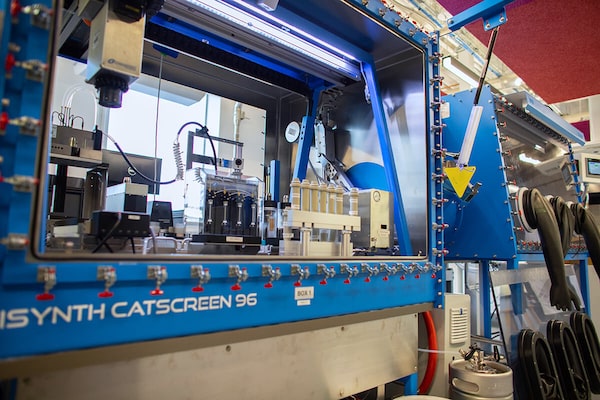
Alán Aspuru-Guzik poses with a robotic arm in The Matter Lab.LIZ BEDDALL PHOTO COURTESY OF CIFAR
A new initiative at the University of Toronto is developing the materials of the future, and making it easier for companies and consumers to address global challenges such as climate change.
The Acceleration Consortium (AC) joins materials science with artificial intelligence (AI), robotics and advanced computing to rapidly develop materials on demand. New advanced materials with superior performance characteristics are required for green energy storage, sustainable packaging, advanced medical devices and a host of other applications. Construction companies could have access to affordable, low-carbon concrete. New treatments for diseases and the rapid development of antivirals are also on the horizon. Already, the AC has used an AI-powered database to develop a molecule in just one month that could lead to a new drug for treating liver cancer.
At the centre of the AC’s work are self-driving labs (SDLs) that discover materials as much as 100 times faster than is currently possible, and for a tenth or less of the current cost. Operating in a loop that predicts, tests and then synthesizes materials and molecules, SDLs accelerate the methodical work of discovery, freeing scientists to focus on designing and refining the research objectives. The AC is building multiple such labs, which enable accelerated research at scale.
As new applications multiply, SDLs will make the AC and its Canadian ecosystem the world’s leading hub for visionary talent and companies seeking a competitive edge through scientific discovery.
We talked to Alán Aspuru-Guzik, director of the Acceleration Consortium, about why he believes this technology can meet the scale and urgency of humanity’s biggest challenges. Aspuru-Guzik is the Canada 150 Research Chair in Theoretical Chemistry in the departments of chemistry and computer science at U of T and Canada CIFAR AI Chair at the Vector Institute.

A self-driving lab is capable of automated liquid dispensing, solid dispensing and high-throughput batch synthesis.PHOTO BY JOHNNY GUATTO © THE MATTER LAB/ACCELERATION CONSORTIUM, UNIVERSITY OF TORONTO
In a short period of time, the Acceleration Consortium has created a global network of universities, funders and industry. Why is this structure important?
It’s simple: You need to involve all stakeholders in solving complex, global problems. We’re a global community of researchers, industry leaders and policymakers working in such areas as AI, materials science and robotics.
And you can’t just stay in your corner of industry or government or academia and do it alone. You need all stakeholders in the room at the same time working together and using their strengths. We decided to call this a consortium instead of an institute because it’s more representative of the intimate collaboration between all of the involved participants.
How does this structure help basic research translate into solutions faster?
The driving idea behind the consortium is that we need faster and more responsive research, and U of T is the hub that brings this community and this research together. By working together with the labs of partners around the world, we’ll be able to scale technological breakthroughs and speed up commercialization. The most impactful project in my lab right now involves six laboratories around the world, including mine, co-ordinated by our unique software system driven by AI. So a lot can be done with localized laboratories where different researchers are working on different parts of a project.
Why is Toronto an ideal location for this work?
This city is becoming one of the most important tech hubs in the world. We’re one of the world’s most diverse cities with reservoirs of talent and expertise. Canada is also open to immigration, so we attract some of the top minds. We have all the elements to be a hub for innovation, and we’re hiring a diverse group of people, including AI experts, roboticists, social scientists and software engineers – we’re going to be the United Nations of this field of science and engineering. There’s also a huge investment in AI in Canada.
Why is U of T the centre of this hub?
U of T has a very interesting position in university rankings because we’re ranked amongst the top of most fields that are engaged in the consortium, including artificial intelligence, computer science and chemical engineering.
So it is this kind of multidisciplinary aspect – and being one of the largest and best public institutions in North America – that makes U of T an ideal place for this type of collaboration.
The consortium is dedicated to open science. Can you explain what this means?
There’s always a trade-off between the speed of innovation and protecting your intellectual property (IP). What we decided to do with the consortium is release our data sets and operate in an open environment, with some exceptions where we might work with a company or third party that’s constrained to a particular IP. But the bulk of our efforts is going to be in an open-source setting to accelerate research.
The open science approach facilitates widespread and rapid translation, and the platform and tools created will be used to create protected IP for applied research advancements to help ensure Canada and Canadians benefit first from these developments. The AC’s open science research hub is committed to the principles of transparency and public accessibility.
What is an example of a global project you are working on?
One project we’re working on is called MADNESS (Molecular Accelerated Discovery of Novelty Enabled by Synthetic Systems). The idea behind this project is to use automation and AI tools to discover the next generation of organic laser molecules. The bottom line is that before we started, there were roughly 10 organic laser molecules published in the world. My lab created 500 lasers in the past three months, and I’m proud to say we have the best organic laser candidate molecule in the world right now.
These organic lasers could be used to emit directional light to the eyes of a person wearing extended reality glasses to name just one of the futuristic applications they could enable.
“U of T recently received $200-million from the Canada First Research Excellence Fund (CFREF) to support the Acceleration Consortium. The CFREF grant allows us to do big science with an incredible scope and potential for impact in a way that’s critical for Canada to remain competitive on the international stage.”
— Leah Cowen, Vice-President, Research and Innovation, and Strategic Initiatives
Advertising feature produced by Globe Content Studio with University of Toronto. The Globe’s editorial department was not involved.